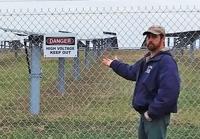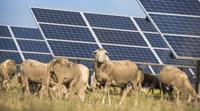Solar energy has its backers who believe that clean and low-cost energy should prevail over critics who say it’s not really that cheap, and that its appearance is a visually jarring presence in the rural landscape.
Three solar experts who think about these issues shared their thoughts in an hourlong webinar on Monday as part of the virtual Pennsylvania Farm Show.
The panelists were Amanda Eyer of the Pennsylvania Department of Environmental Protection, Tom Murphy of Penn State’s Marcellus Center for Outreach and Research, and Dave Hartman of Penn State Extension.
Their focus was on the deployment of utility-scale solar, rather than the kind of solar panels that can keep electric fences charged and, with rooftop installations, power a house or barn.
Utility-scale installations can cover hundreds of acres of bucolic countryside, limiting the land’s use for crop and livestock agriculture.
Unlike coal- and gas-powered generation stations, solar is a zero-emissions source of energy.
Solar’s cost structure and environmental friendliness can help Pennsylvania meet goals for clean, economical electricity, according to Eyer.
Pennsylvania gets 7% of its energy from renewable sources, including 1% from solar.
The Department of Environmental Protection wants to raise solar’s portion to 10% by 2030, part of a broader Wolf administration goal to reduce greenhouse gases 80% by midcentury.
Eyer showed a map of Pennsylvania’s 67 counties. Proposed solar installations are planned for 53 of them, covering a land area of about 60,000 acres. By comparison, Eyer said, Pennsylvania has 250,000 acres of abandoned mine lands.
- Tom Venesky, Northeast Pennsylvania Correspondent
The Price of Setting Up Solar
Solar energy does have a significant price tag, Eyer said. But with all expenses counted, such as construction, maintenance and land acquisition, solar costs about $37 per megawatt-hour, which is about half the cost of a fossil fuel-burning plant.
But that’s not the only economic incentive for distributors of electricity. The state mandates that companies like PPL and MetEd buy a percentage of their electricity from renewable sources, and those sources must be located in Pennsylvania.
Murphy gave a virtual tour of Penn State’s 500-acre solar facility in Franklin County. It’s big and there’s no doubting its purpose. Fences divide the facility into different areas for different studies.
One section is laid out to research if hay crops can be grown and harvested in the space between rows of panels. And there’s a fenced-off corridor through the installation to allow for the passage of wildlife.
Is it beautiful? That would depend on the eye — and maybe more importantly, the mindset — of the beholder.
- Susan Schoenian, University of Maryland Extension
Sheep Can Help Maintain Ground Under Solar Panels
Hartman, an Extension educator based in Lycoming County, likes sheep for maintaining the ground under solar panels.
Goats don’t work in solar farms because they tend to climb on the panels with their sharp hooves. With their tendency to rub against things, cattle could damage the supports for the panels.
Sheep just eat and don’t bother the solar structures.
Hartman said the issue with cattle might be solved by putting the panels higher up on sturdier supports. That idea would take research to validate and extra expense to implement.
One point in favor of sheep is a growing market for lamb in the Northeast. Hartman said most of the lamb meat currently moving into the New York, Boston and Philadelphia markets is being trucked in from outside the region.
For a farmer and energy entrepreneur, Hartman suggested starting with three ewes per acre of solar farm. “I like to suggest low, see what happens, and then go up from there,” he said. Wethers and nonbreeding ewes could also be used for maintenance.
Sheep can get a lot of their daily water need from the forages they eat, but Hartman said anybody thinking of employing sheep for maintenance would need to plan for a water supply.
Probably the biggest challenges a producer would face are timing the lamb crop and getting the animals to market. He suggested looking closely at the numbers to figure out the extra labor, trucking, supplemental feed, veterinary services and other costs involved with any farm enterprise.



